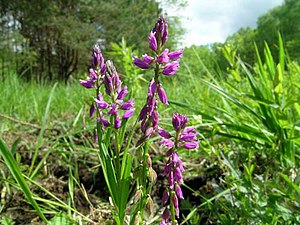Scaly finial
| Scaly finial | ||||||||||||
|---|---|---|---|---|---|---|---|---|---|---|---|---|

Scaly finial ( Polygala comosa ) |
||||||||||||
| Systematics | ||||||||||||
|
||||||||||||
| Scientific name | ||||||||||||
| Polygala comosa | ||||||||||||
| Schkuhr |
The Schopfige finial ( Polygala comosa ), also Schopf-milkwort called, is a species of the genus finials ( Polygala ) within the family of polygalaceae (Polygalaceae).
description
Vegetative characteristics
The crested finial is a deciduous, perennial herbaceous plant and reaches heights of 5 to 30 centimeters. It forms a thin tap root and a branched rhizome with fertile and sterile shoots. The stems are ascending to upright, mostly unbranched or only branched at the base.
The alternate leaves are herbaceous. The lower leaves are not heaped in a rosette . The leaves get smaller towards the top of the stem. The leaf blades of the lower leaves are narrow spatulate to obovate and usually fall off during flowering. The upper leaves are linear to linear-lanceolate and pointed.
Generative characteristics
The flowering period extends from May to August. Many (15 to 50) flowers stand together in a terminal, dense, racemose inflorescence . Initially the inflorescence is conical and later becomes cylindrical. The bracts are linear-lanceolate, significantly longer (two to three times as long) than the flower stalk and protrude over the flower buds by more than 1 millimeter before they open. The bracts are ciliate and mostly present at the anthesis . The bracts protrude above the buds, which makes the tip of the inflorescence look scaly, hence the common name crested cruciferous and the epithet comosa .
The hermaphrodite flowers are zygomorphic with a double flower envelope . The bracts are pink, rarely blue or white. The wings are 3.5 to, usually 4 to 6 millimeters long and 2 to, usually 2.5 to 4 millimeters wide, and have one to three nerves. At fruit time they have zero to six meshes and the veins are indistinct. The crown is 4.5 to 8 millimeters long, as long as or slightly longer than the wings. The appendage of the lower petal has 14 to 30 (up to 35) fringes.
The obverse-heart-shaped capsule fruit with a length of about 5 millimeters has a wedge-shaped base. The fruit is shorter than the wings and has a wing about 0.5 millimeters wide. The seeds have hairy appendages, the lateral lobe is about a third as long as the seed.
The number of chromosomes is 2n = 28, 28–32 or 34.
ecology
The crested finial is a scleromorphic, mesomorphic hemicryptophyte .
From an ecological point of view, it is a nectar-bearing butterfly flower. The pollination is done by bees and butterflies . It is a wind spreader, the free seeds are also carried away by ants.
Occurrence
The crested finial is native to the submeridional to temperate areas of sub-oceanic Europe. It occurs in Central Europe. In Germany it is widespread in the south, rarely or absent in the north. In Austria it occurs in all federal states and is generally common, but is endangered in the Bohemian Massif, in the northern Alpine foothills and in the Pannonian region.
It grows in Kalktrocken- and semi- dry grassland and is a class characteristic species of fescue Brometea with a focus on Mesobromion . It occurs from the colline to the subalpine altitude .
swell
literature
- Manfred A. Fischer, Wolfgang Adler, Karl Oswald: Excursion flora for Austria, Liechtenstein and South Tyrol . 2nd, improved and enlarged edition. State of Upper Austria, Biology Center of the Upper Austrian State Museums, Linz 2005, ISBN 3-85474-140-5 .
- Rudolf Schubert , Klaus Werner, Hermann Meusel (eds.): Excursion flora for the areas of the GDR and the FRG . Founded by Werner Rothmaler. 13th edition. tape 2 : vascular plants . People and knowledge, Berlin 1987, ISBN 3-06-012539-2 .
- Siegmund Seybold (Ed.): Schmeil-Fitschen interactive . CD-ROM, version 1.1. Quelle & Meyer, Wiebelsheim 2002, ISBN 3-494-01327-6 .
Individual evidence
- ↑ a b c d e f g h i Polygala comosa Schkuhr, Schopf-Kreuzblümchen. In: FloraWeb.de.
- ^ Erich Oberdorfer : Plant-sociological excursion flora for Germany and neighboring areas . With the collaboration of Angelika Schwabe and Theo Müller. 8th, heavily revised and expanded edition. Eugen Ulmer, Stuttgart (Hohenheim) 2001, ISBN 3-8001-3131-5 , pp. 642 .
Web links
- Scaly finial . In: BiolFlor, the database of biological-ecological characteristics of the flora of Germany.
- Profile and distribution map for Bavaria . In: Botanical Information Hub of Bavaria .
- Polygala comosa Schkuhr In: Info Flora , the national data and information center for Swiss flora .
- Thomas Meyer: Data sheet with identification key and photos at Flora-de: Flora von Deutschland (old name of the website: Flowers in Swabia )
- Wanted poster with photos.
- Data sheet with photos.
- Distribution in the northern hemisphere from: Eric Hultén, Magnus Fries: Atlas of North European vascular plants. 1986, ISBN 3-87429-263-0 at Den virtuella floran. (swed.)

